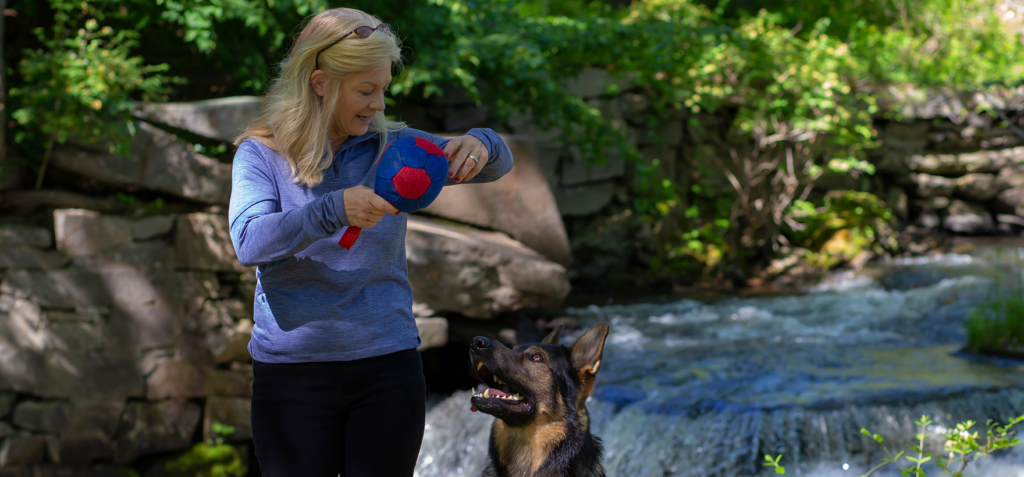Ever wonder why some dogs seem to stay effortlessly connected to their handlers in all kinds of environments—busy parks, crowded streets, bustling training classes? I’ve been fortunate to share my life with three such dogs. No matter where we went, they remained mentally and emotionally available to me. They were steady, grounded, and attentive, even in the midst of chaos. What they shared was a rare combination of strong environmental and social confidence. Simply put, nothing really bothered them. Loud sounds, sudden movements, unfamiliar sights or people—they took it all in stride. They were not easily startled or concerned. They were the opposite of what we would call a sensitive dog.
Sensitive dogs, on the other hand, often struggle to maintain that same level of connection, especially in unfamiliar or stimulating environments. These dogs are, by nature, more prone to stress and anxiety. They have less emotional bandwidth to absorb and process stimuli. When they are worried about people, dogs, novel objects or sound, they can disconnect and pull their focus away from their human.
If a dog is socially insecure, for instance, and is worried about nearby people, that concern will often override their ability to “think and respond” to our cues. You might see them flick an ear back toward you as if to say, “I hear you”, but they can’t take their eyes—or their mind—off whatever is worrying them. It’s not defiance nor is it stubbornness; it’s emotional overload. Their capacity to stay connected is compromised — not because they don’t want to, but because they can’t in that moment.
Understanding the difference
Understanding if your dog is sensitive to something she sees, feels, smells or hears is essential when trying to engage them. Not all behavior responses stem from the same place, and recognizing this can help guide how we support each individual dog. For example, the dog who enthusiastically pulls you to a nearby post to sniff is driven by curiosity and confidence—very different from the dog who steps outside and immediately starts barking at apparently nothing. These behaviors should look different as one is purposeful and the other is chaotic, the motivation behind them is also fundamentally different.
Purposefully taking space is driven by intention and often a regulated emotional state—whether it’s curiosity, or independence. In contrast, frantic behaviors like sudden barking, jumping on their guardian or frantically pulling may stem from overwhelm, fear, or hyper-vigilance. Understanding the emotional root behind a dog’s actions allows us to respond with empathy and clarity rather than assumptions or frustration. By observing what stimulates or concerns them—be it sights, sounds, textures, or smells—we can better support them and build trust. Ultimately, engagement begins with awareness, not obedience: a responsive dog is one who feels seen, safe, and supported.
So what can you do to help your dog stay more connected, especially if they’re on the more sensitive side? Here are 5 strategies to build stronger connection and presence with your dog in any setting:
1. Start Where They Can Succeed
Train in a familiar, low-stress environment where your dog can think clearly and focus on you and only you. This helps build trust and teaches them how to learn in partnership with you. You’re creating a shared language in a space where they feel safe.
2. Ease Into New Places
When entering a new park or social setting, don’t immediately ask for obedience or focus. Start by allowing your dog to check out the new surroundings on a 10-foot leash. This might be visually if your dog has strong visual awareness or it may be putting his nose to the ground and smelling the new setting. If your dog is activated and ready to “do something”, I suggest you play a game your dog loves—whether it’s find it, fetch, or tug. This builds positive associations and helps your dog stay emotionally regulated in the new environment.
3. Join Their Joy
Let your dog lead the way on a longer line of 8 to 10 feet. If they love to dig, walk over to a tree stump and start digging with them! If they want to sniff every bush, join in and explore. They love frisbies? Buy 2 new ones and surprise them with a new one that YOU love. Be excited over this new toy, like it is the best. YES! You must love this toy if you want them to love it also. When you participate in their favorite activities, they feel understood—and that shared experience deepens your connection.
4. Teach the Art of Doing Nothing
Some dogs are observers. They don’t want to jump into action—they want to sit back and take it all in. For these dogs, “doing nothing” can be its own kind of training. Your dog likely knows “go to your bed or mat”, then bring that mat into new settings and simply sit together. Breathe. Watch. Let them learn that being with you, quietly, is a safe and grounding experience. This might be difficult for some dogs, but with practice, they can follow your lead in being still and breathing deeply.
5. Let Curiosity Lead
Instead of forcing engagement, allow your dog to approach and explore new things on their terms. Let them watch the joggers, sniff the bench, or investigate the picnic table—without being rushed or redirected. If you stay close and supportive, they’ll begin to look to you not as a source of pressure, but as a safe partner in their exploration. That’s where true connection is built.
Whether your dog is bombproof or sensitive, the key to staying connected is understanding how they process the world. When we meet them where they are—with patience, playfulness, and presence—we open the door for deeper trust, clearer communication, and a bond that can withstand any distraction.
Repetition Builds Confidence
Sometimes the best thing you can do for a sensitive dog is simply return—again and again—to the same setting. Many dogs need more than one exposure to a new environment before they truly feel safe, and those repeated visits can work wonders for building confidence.
I’ll never forget taking my German Shepherd, Drake, to our local airport. They had an odd little display in the terminal: a row of large taxidermy animals—bears, moose, bobcats—lined up along the wall like a frozen zoo. For Drake, it was sensory overload. He couldn’t settle, couldn’t relax, and definitely couldn’t focus.
But instead of pushing him through it, I chose to return with him—over and over again. Each visit, we kept things light and fun, staying just long enough to play a favorite game or practice simple behaviors away from the display. Gradually, the stress began to fade, sometimes with the help of his favorite stoic, black lab, Cody. After five or six visits, often with Cody in the lead, something shifted. Drake walked by the taxidermy with barely a glance. By the seventh time, he could lie down and rest near them as if they didn’t exist.
That moment was a reminder: progress with sensitive dogs often happens in layers. When we give them time, patience, and repeated positive experiences, their world starts to feel safer—and they are able to stay more connected to us within it.


